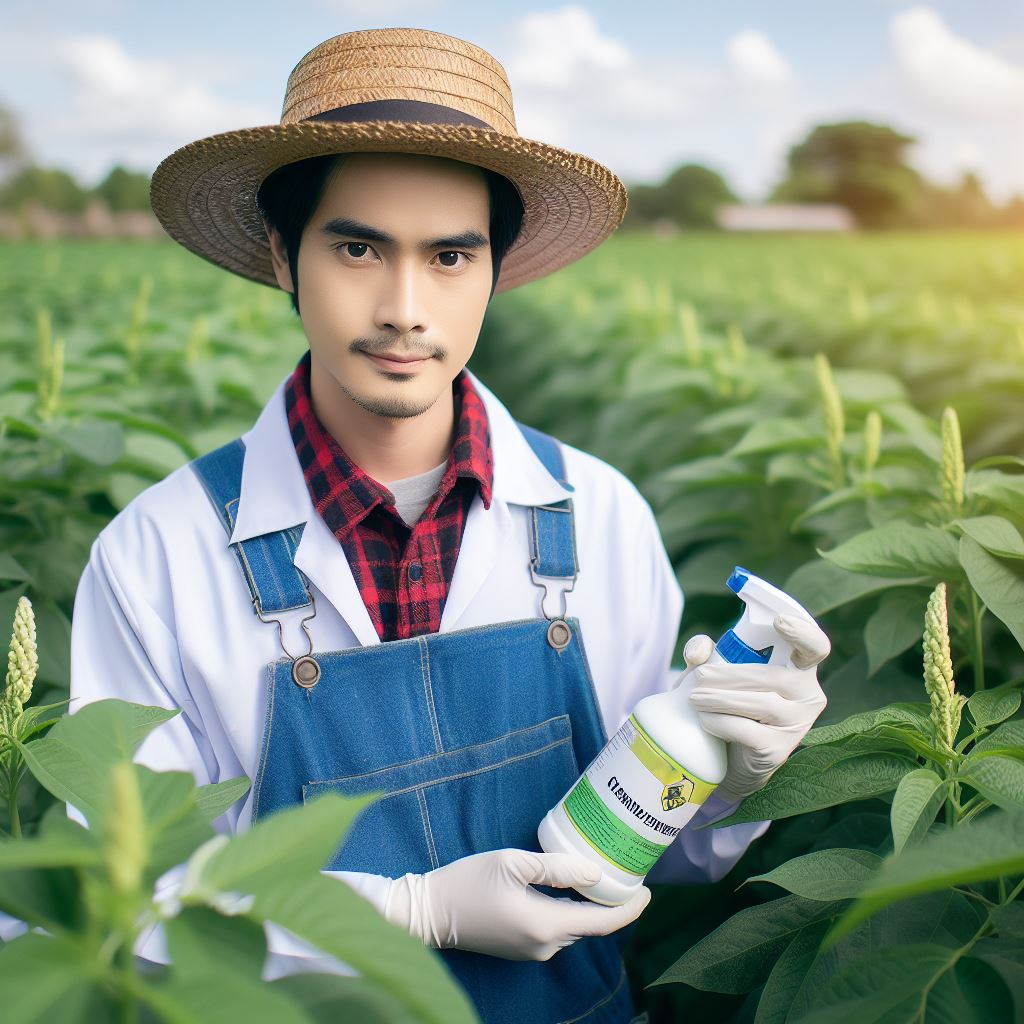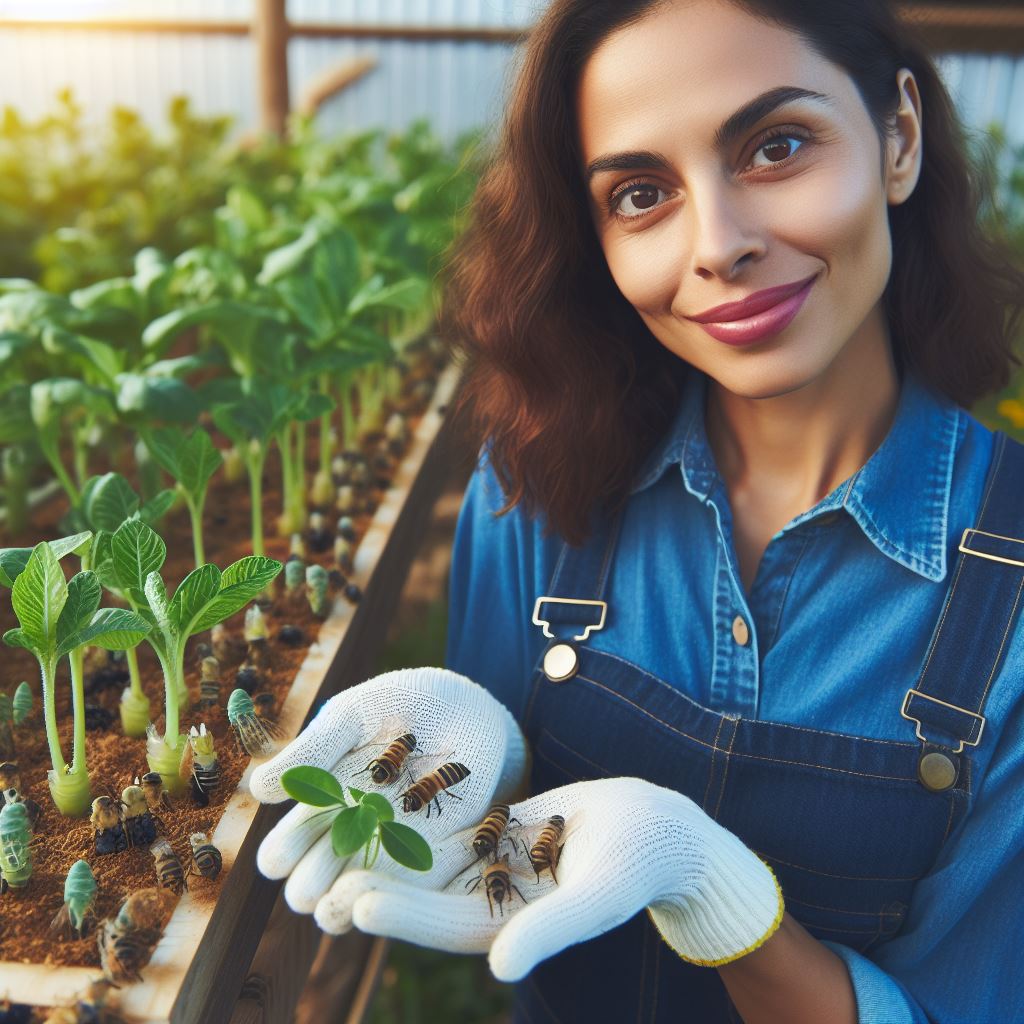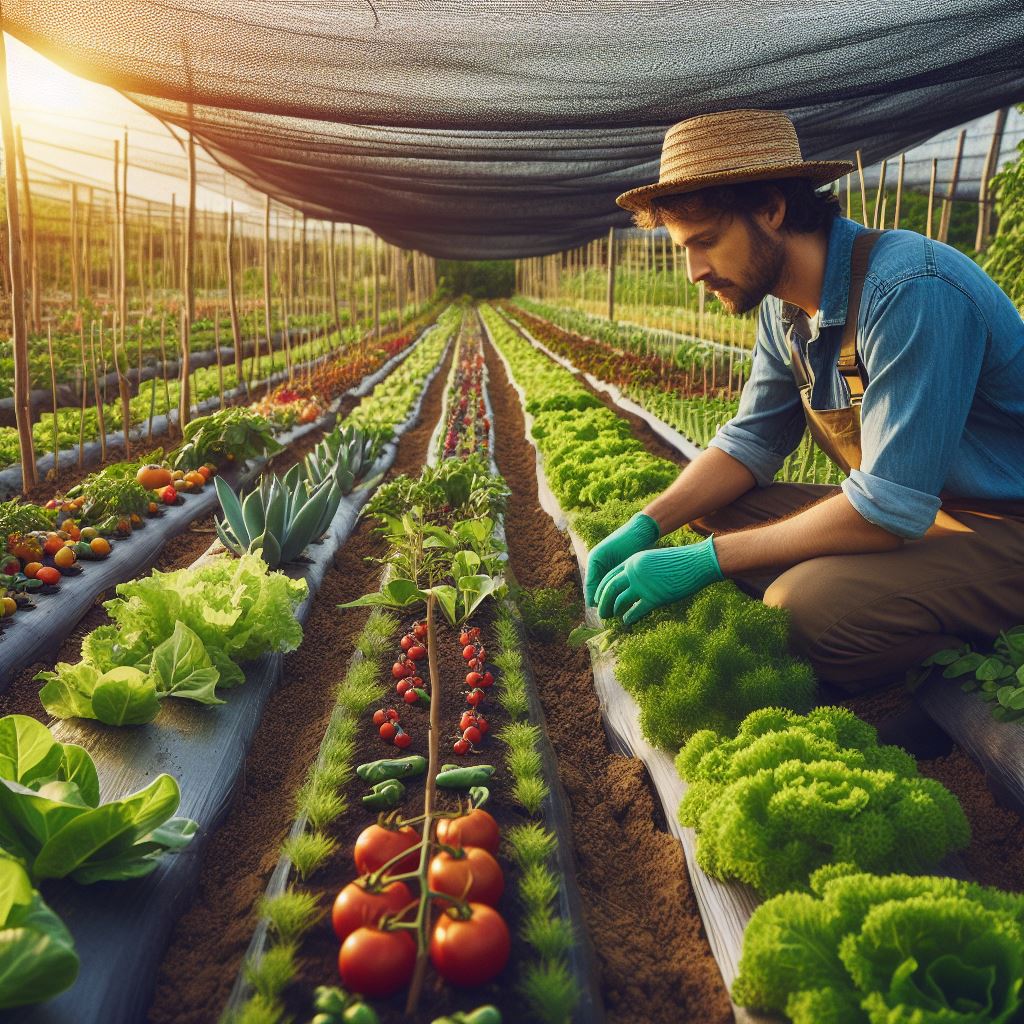Introduction
Chemical control is a widely used method in agriculture to protect crops from pests and diseases.
Farmers rely on various chemical substances, such as pesticides and herbicides, to ensure healthy and abundant crop yields.
These chemicals are designed to target specific pests and diseases, minimizing the damage they can cause to crops.
However, it is essential to examine the safety of chemical control methods for crops. The use of chemicals raises concerns about potential negative effects on human health and the environment.
Understanding the safety implications is crucial for ensuring the sustainability and long-term viability of agricultural practices.
One reason why discussing the safety of chemical control is important is to protect the health and well-being of farmers and consumers. Prolonged exposure to certain chemicals used in crop protection can have adverse health effects.
By evaluating the safety of chemical control methods, appropriate measures can be taken to minimize potential health risks and prevent any negative impacts on human health.
Furthermore, considering the safety aspects of chemical control is essential for preserving the environment. Some chemicals can persist in soil and water, causing contamination and detrimental effects on ecosystems.
Evaluating the safety of these substances helps in developing sustainable practices that minimize pollution and preserve biodiversity.
In essence, chemical control in agriculture is a common practice for protecting crops. However, discussing the safety of these methods is important for safeguarding human health and the environment.
By ensuring the use of safe and sustainable practices, we can cultivate healthy crops while minimizing negative impacts on our ecosystem.
Benefits of Chemical Control
Increased crop yields
One of the primary advantages of chemical control is the substantial increase in crop yields.
By using pesticides and herbicides, farmers are able to reduce the competition from weeds and eliminate or control harmful pests, resulting in healthier plants and improved productivity.
With chemical control, crops are better protected from diseases and pests, leading to a more abundant and reliable food supply.
Reduction in pest damage
Another noteworthy benefit of chemical control is the reduction in pest damage. Pests, such as insects and rodents, can cause significant damage to crops, resulting in reduced yields and economic losses for farmers.
Transform Your Agribusiness
Unlock your farm's potential with expert advice tailored to your needs. Get actionable steps that drive real results.
Get StartedChemical control methods control or eliminate these pests efficiently, preventing crop loss and reducing the need for costly replanting or additional resources to combat infestations.
Cost-effectiveness
Additionally, chemical control is often cost-effective. Compared to alternative pest management methods, such as biological control or cultural practices, chemical control is generally more affordable.
The initial investment in pesticides or herbicides may seem high, but the long-term benefits outweigh the costs. Chemical control allows for targeted application, minimizing waste and ensuring efficient use of resources.
Furthermore, chemical control methods offer convenience and accessibility to farmers, as they can be easily applied on a large scale.
This is especially important for commercial agriculture, where time and efficiency are critical. Chemical control allows farmers to protect their crops quickly and effectively, saving labor and ensuring optimal crop growth.
While chemical control has its benefits, it is essential to acknowledge the potential concerns and risks associated with its use. Some argue that chemical control can harm non-target organisms and negatively impact the environment.
However, advancements in pesticide formulations and application techniques have addressed many of these concerns. Integrated Pest Management (IPM) programs promote the responsible and judicious use of chemical control, minimizing adverse effects on the environment.
In fact, chemical control offers numerous benefits for crop production. Increased crop yields, reduced pest damage, and cost-effectiveness are some of the advantages that make chemical control an attractive option for farmers.
However, it is crucial to acknowledge the importance of responsible pesticide use and consider alternative pest management methods to minimize any potential risks.
By using chemical control in conjunction with sustainable farming practices, we can ensure a safer and more productive agricultural industry.
Types of Chemical Control Methods
Chemical control methods are commonly used in agriculture to protect crops from pests and diseases.
These methods involve the use of various chemicals to target specific pests and diseases, but the safety of these chemicals for crops is a topic of concern.
In this section, we will explore the different types of chemical control methods and evaluate their safety for crops.
Herbicides
Herbicides are chemicals used to control weeds in agricultural fields.
They work by either killing the weeds or inhibiting their growth. While herbicides are effective in controlling weeds, their safety for crops depends on several factors.
The dosage and application method must be carefully regulated to ensure that only the weeds are affected and not the crops.
Insecticides
Insecticides are chemicals designed to kill or repel insects that damage crops. They are classified into two main categories: broad-spectrum and selective insecticides.
Broad-spectrum insecticides can be harmful to crops as they not only target pests but also beneficial insects. On the other hand, selective insecticides specifically target certain pest species, minimizing their impact on crops.
Fungicides
Fungicides are used to control fungal infections in crops. They work by inhibiting the growth and spread of fungi.
However, the safety of fungicides for crops is a concern because some fungicides can also harm beneficial fungi that aid in nutrient absorption and disease resistance.
Proper timing and application of fungicides are crucial to minimize their impact on crops.
Rodenticides
Rodenticides are chemicals used to control rodent populations in agricultural fields.
They are often used to protect stored crops from rodent damage. However, the safety of rodenticides for crops is a major concern due to the potential for contamination.
Improper use of rodenticides can lead to residues in crops, posing health risks for consumers.
Showcase Your Farming Business
Publish your professional farming services profile on our blog for a one-time fee of $200 and reach a dedicated audience of farmers and agribusiness owners.
Publish Your ProfileNow that we have examined the different types of chemical control methods, it is important to address their safety for crops.
While these chemicals can be effective in managing pests and diseases, their potential negative impacts cannot be ignored.
To ensure the safety of chemical control methods for crops, it is crucial to follow proper guidelines and regulations. This includes using the recommended dosage, following application methods, and adhering to safety precautions.
Additionally, integrated pest management (IPM) practices should be adopted, which aim to minimize chemical use by combining various pest control strategies.
Regular monitoring and evaluation of crop health should also be conducted to identify any negative effects of chemical control methods.
If adverse effects are observed, alternative approaches should be considered to minimize risks to crops and the environment.
In all, chemical control methods, such as herbicides, insecticides, fungicides, and rodenticides, play a vital role in protecting crops from pests and diseases.
However, their safety for crops depends on proper usage and adherence to guidelines.
By implementing integrated pest management practices and regularly monitoring crop health, the potential negative impacts of chemical control methods can be minimized, ensuring the safety of crops and the environment.
Read: Preventing Soil Erosion Naturally
Potential Risks of Chemical Control
Environmental impact
Chemical control methods can have a significant negative impact on the environment. The use of pesticides and herbicides can lead to pollution of water bodies, affecting aquatic ecosystems and harming various species of plants and animals.
Pesticides can also contaminate the soil, leading to long-term damage to the fertility and overall health of the ecosystem. These chemicals can disrupt the natural balance of organisms, including beneficial insects and microbes, leading to a decline in biodiversity.
Furthermore, the application of chemical controls can result in the loss of beneficial habitats such as hedgerows and wetlands. These habitats provide crucial resources and shelter for a variety of organisms, and their destruction can further disrupt the ecological balance.
Human health concerns
Chemical control methods can pose significant risks to human health. Exposure to pesticides and herbicides can lead to acute or chronic health problems for farmers, farmworkers, and even consumers who consume crops treated with these chemicals.
Prolonged exposure to pesticides has been linked to various health issues, including respiratory problems, birth defects, neurological disorders, and certain types of cancer. The risk is particularly high for those who come into direct contact with these chemicals.
Children are particularly vulnerable as their developing bodies are more susceptible to the harmful effects of pesticides. Exposure to these chemicals at an early age can have long-lasting impacts on their health and development.
Development of pesticide resistance
Another potential risk of chemical control methods is the development of pesticide resistance in pests. Over time, repeated exposure to the same pesticides can lead to the proliferation of resistant pests that can no longer be effectively controlled.
This resistance occurs as a result of natural selection, where pests with genetic variations that enable them to survive pesticide exposure are more likely to reproduce and pass on their resistant traits to future generations.
As a result, higher concentrations of pesticides or alternative chemicals are required to achieve the same level of control, leading to increased costs and environmental impact.
The development of pesticide resistance can also limit the effectiveness of chemical control methods, rendering them less useful over time. This can create a vicious cycle where more potent and toxic chemicals need to be used, further exacerbating the environmental and health risks.
In conclusion, while chemical control methods can provide short-term benefits in crop protection, they also come with potential risks. The environmental impact can lead to pollution, loss of biodiversity, and damage to ecosystems.
Human health concerns include acute and chronic health effects, with children being particularly vulnerable. Additionally, the development of pesticide resistance poses long-term challenges for effective pest control.
Therefore, it is crucial to adopt alternative, sustainable approaches to crop protection that minimize the use of chemicals and prioritize environmental and human health.
Read: Sustainable Water Use in Farms

Regulations and Safety Measures
Government regulations on pesticide usage
The government plays a vital role in regulating the usage of pesticides in crop production. These regulations are implemented to ensure the safe and responsible use of chemical control methods.
1. Pesticide registration and labeling
Government authorities require pesticide manufacturers to register their products and provide accurate and detailed labels. This ensures that farmers and users have access to essential information about safe handling, application, and storage.
2. Restricted use pesticides
In some cases, certain pesticides are classified as restricted use products, which means that only certified applicators can purchase and use them. This helps prevent misuse and reduces the risk of exposure to harmful chemicals.
3. Maximum residue limits
Regulatory bodies set maximum residue limits (MRLs) to control the amount of pesticide residues allowed to remain in or on food commodities. These limits ensure that consumers are not exposed to harmful levels of pesticides through their diet.
Proper handling and application techniques
The safe and effective use of pesticides depends on proper handling and application techniques. Adhering to these practices minimizes potential risks to crops, the environment, and human health.
1. Protective equipment and clothing
Farmers and applicators must wear appropriate protective equipment, including gloves, goggles, and masks, to prevent direct contact with pesticides. This minimizes the risk of skin, eye, or respiratory irritations.
2. Calibration of application equipment
Applicators need to calibrate their equipment regularly to ensure accurate and precise application rates. This helps prevent under or over-application, reducing the potential for environmental contamination and crop damage.
3. Correct timing and weather conditions
Applying pesticides at the right time, considering the target pest’s life cycle and weather conditions, is crucial. This reduces the need for excessive pesticide use and increases effectiveness while minimizing environmental impact.
Integrated Pest Management (IPM) approach as a safer alternative
Integrated Pest Management (IPM) is an environmentally friendly approach that promotes the use of multiple strategies to control pests, reducing reliance on chemical controls.
1. Biological control
IPM encourages the use of natural enemies, such as predators, parasites, and beneficial insects, to control pest populations. This method is safe for crops, as it minimizes chemical use and has no adverse effects on the environment.
2. Crop rotation and diversification
Rotating crops and planting diverse species disrupts pest life cycles while improving soil health and reducing pest buildup. This sustainable practice is an integral component of IPM and contributes to long-term crop health.
3. Monitoring and threshold levels
Regular pest monitoring helps farmers identify pest populations and implement control measures when pest numbers reach predetermined threshold levels. This prevents unnecessary pesticide applications and promotes targeted control.
4. Education and training
IPM emphasizes the importance of education and training for farmers and applicators.
Providing knowledge about pest identification, monitoring techniques, and alternative control methods empowers individuals to make informed and responsible decisions regarding crop protection.
In general, regulations and safety measures play a crucial role in ensuring the safe use of chemical control methods in crop production.
Government regulations, proper handling techniques, and the adoption of integrated pest management approaches promote crop safety while minimizing environmental impact and protecting human health.
Showcase Your Farming Business
Publish your professional farming services profile on our blog for a one-time fee of $200 and reach a dedicated audience of farmers and agribusiness owners.
Publish Your ProfileRead: Best Times to Harvest Corn: Key Tips & Tricks
Case Studies
Examples of success stories using chemical control safely
Chemical control has proven to be an effective tool in crop management, with numerous success stories showcasing its safe usage. These examples demonstrate the positive impact that chemical control can have on crop yields and overall agricultural productivity.
- The Green Revolution in India: During the 1960s and 1970s, India faced a severe food shortage crisis. With the implementation of chemical control measures such as fertilizers and pesticides, the country experienced a significant increase in crop production. This led to self-sufficiency in food production and uplifted millions from poverty.
- Increased pest resistance in cotton crops: In the early 2000s, cotton farmers in the United States were facing devastating losses due to the cotton bollworm. However, with the introduction of genetically modified cotton varieties, which were resistant to pests, the use of chemical control became highly effective. This resulted in increased yields and reduced reliance on harmful insecticides.
- Effective weed control in soybean crops: Weed infestations can significantly impact crop growth and yield. Through the use of herbicides, farmers have successfully controlled weed growth in soybean fields, ensuring healthier plants and higher productivity. Herbicides are specifically designed to target weeds without harming the crops, making them a safe and efficient means of chemical control.
Instances where chemical control led to negative consequences
While chemical control has its benefits, there have been cases where its improper or excessive usage has led to negative consequences. These instances serve as reminders of the importance of using chemicals judiciously and considering alternative methods of crop protection.
- Pesticide drift and environmental impact: Pesticides, when applied incorrectly, can drift from the target area and contaminate nearby water bodies, soil, and wildlife habitats. This can lead to adverse effects on non-target organisms, including beneficial insects, birds, and aquatic life. It highlights the need for proper application techniques and adherence to safety guidelines.
- Development of pesticide resistance: Repeated and indiscriminate use of pesticides can contribute to the evolution of pesticide-resistant pests. This occurs when pests are exposed to the same chemical control for extended periods, allowing them to develop genetic traits that render them unaffected by the chemicals. Farmers then face the challenge of finding alternative control methods.
- Soil degradation and nutrient imbalance: Certain chemicals used in crop production, such as excessive nitrogen-based fertilizers, can lead to soil degradation and nutrient imbalances. This can result in poor soil quality, reduced crop productivity, and environmental pollution. Balancing chemical control with sustainable soil management practices is crucial to prevent these negative consequences.
Essentially, case studies highlighting both the success stories and negative consequences of chemical control in crop management emphasize the need for responsible and informed decision-making.
While chemical control can be a powerful tool for enhancing agricultural productivity, it must be used carefully and in conjunction with sustainable practices to minimize risks to the environment and human health.
By considering alternative methods and adopting integrated pest management strategies, farmers can strike a balance between effective crop protection and long-term sustainability.
Read: No-Till Farming: Pros & Cons
Conclusion
In this section, we discussed the main points regarding chemical control in crop production. Chemical control in agriculture involves using pesticides and herbicides to manage pests and weeds.
While effective, concerns over safety persist. Main points discussed include the benefits of chemical control in enhancing crop yields and reducing losses due to pests and weeds.
However, risks such as environmental damage, health hazards, and development of pesticide resistance were highlighted. Integrated Pest Management (IPM) emerged as a balanced approach, combining chemical control with biological and cultural methods to minimize risks.
Emphasis was placed on regulatory measures, proper application techniques, and ongoing research into safer alternatives for sustainable agriculture.
By weighing the benefits and risks of chemical control, we can make informed decisions. However, it is crucial to call for further research and responsible usage of chemicals in agriculture.




